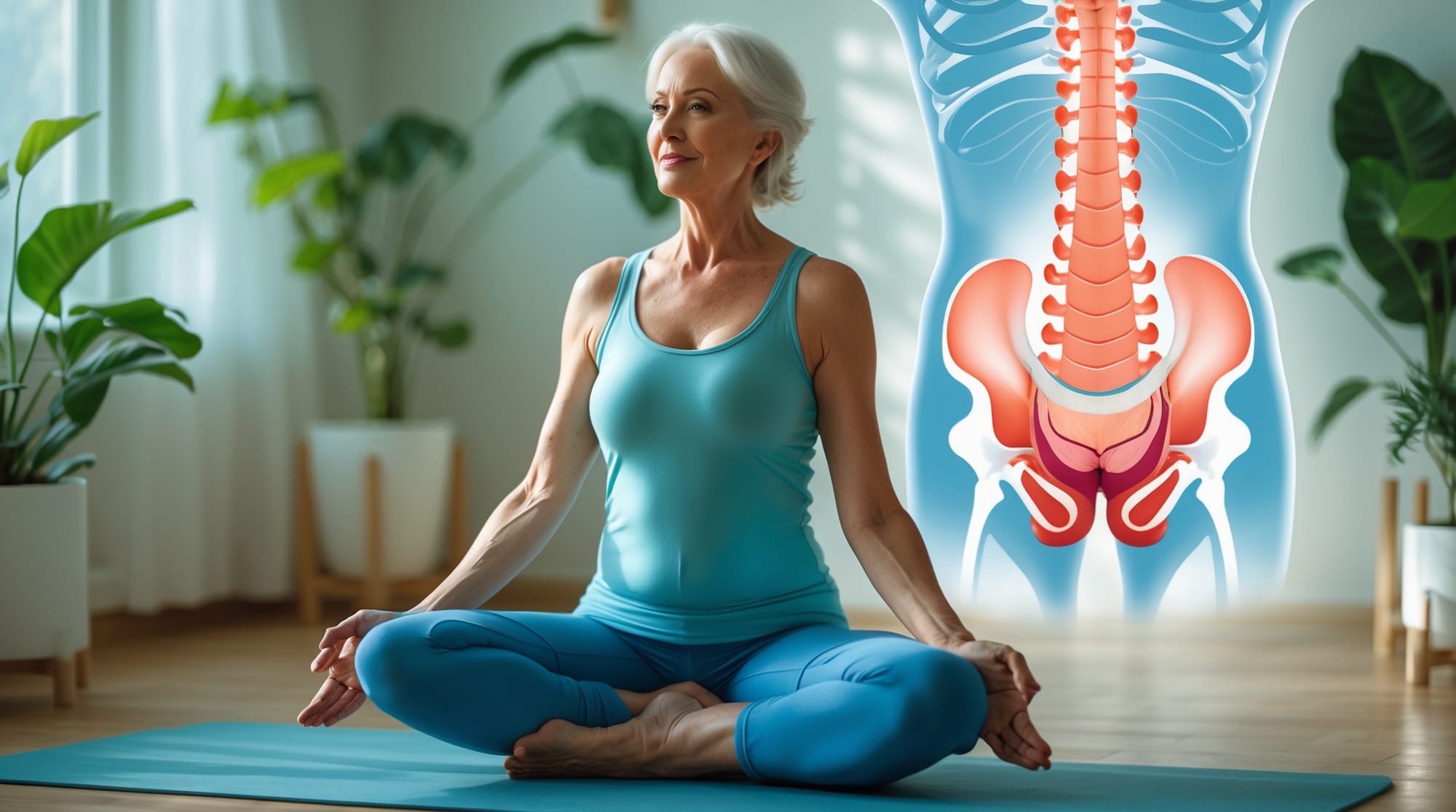Pelvic Floor Health After 50: Why It Matters More Than You Think
Pelvic floor health becomes crucial after 50—impacting bladder control, sexual wellness, and quality of life. Learn the exercises, lifestyle tips, and medical insights that can help you stay strong, confident, and supported through aging.

As we get older, keeping our pelvic floor healthy becomes more important. It affects our daily life a lot. This group of muscles helps us control our bladder, stay sexually healthy, and feel good overall.
Studies by the American Urogynecologic Society, the International Continence Society, and the National Institute on Aging show a big benefit. They found that focusing on pelvic floor health can greatly improve our life quality. This is true, even for those over 50 who struggle with incontinence.
With the right tips, like exercises, diet changes, and lifestyle adjustments, you can fight the discomforts of weak pelvic muscles. This way, you can greatly improve your quality of life.

Key Takeaways
- The pelvic floor is key for bladder control and sexual health.
- Managing incontinence greatly boosts quality of life.
- Pelvic floor exercises can strengthen muscles after 50.
- Dietary changes help support pelvic health.
- Lifestyle changes contribute to overall well-being.
Understanding Pelvic Floor Health
The pelvic floor is a key part of our body, more so as we get older. It's located in the pelvis and helps support organs and keep our body working right. Knowing about pelvic health and aging is key for staying healthy.
What is the Pelvic Floor?
The pelvic floor has layers of muscles that stretch from the front to the back of the pelvis. These muscles help hold up the bladder, rectum, and uterus in women. They also help control when we pee and poop and are important for sex.
The Importance of Pelvic Floor Health
Keeping the pelvic floor muscles strong is very important, even more so as we age. A strong pelvic floor helps us stay continent, supports sexual health, and keeps the pelvis stable. Things like childbirth and menopause can weaken these muscles. So, it's vital to understand how important pelvic floor health is. Strengthening these muscles helps us age healthily.
Common Issues With Pelvic Floor Health After 50
As we get older, our pelvic floor muscles get weaker. This can lead to health problems. It's important to know about these issues to stay healthy.
Urinary Incontinence
Urinary incontinence affects 30-60% of women over 50. It means losing urine without meaning to. This can make daily life hard and affect how we feel.
It happens because of weak muscles, hormonal changes, and bladder pressure. To fix it, we can do exercises, change our lifestyle, or get medical help.
Pelvic Organ Prolapse
Pelvic organ prolapse happens when pelvic organs drop because of weak muscles. This can cause discomfort and incontinence. It's more common after childbirth and menopause.
Treatment depends on how bad it is. We might need to change our lifestyle, do physical therapy, or have surgery.
Other Pelvic Floor Dysfunctions
There are other problems like chronic pain, fecal incontinence, and sexual issues. These can come from surgery, trauma, or diseases like diabetes. Spotting these early is key to treating them well.
"Understanding the nuances of these conditions helps in devising effective treatment plans that cater to the unique needs of older adults." - The Journal of the American Medical Association
Here's a table showing how common these issues are and what might cause them:
| Condition | Prevalence | Causes |
|---|---|---|
| Urinary Incontinence | 30-60% of women over 50 | Weak pelvic muscles, hormonal changes |
| Pelvic Organ Prolapse | 50% of women over 50 | Childbirth, menopause, heavy lifting |
| Other Dysfunctions | Varies | Surgery, trauma, chronic conditions |
Effects of Menopause on Pelvic Floor Health
Menopause is a big deal for pelvic health because of the big hormonal changes it brings. Estrogen, a key hormone, helps keep pelvic tissues strong and flexible. When estrogen levels drop, pelvic muscles get weaker. This can cause problems like leaks and prolapse.
Hormone changes in menopause can really mess with pelvic support. This might make pelvic floor disorders more common. Research in Menopause Journal, The Lancet, and American Family Physician shows a strong link between menopause and weaker pelvic structures. These studies help us understand how menopause affects pelvic health.
To fight these effects, we can teach pelvic exercises, change diets, and make lifestyle tweaks. Hormone replacement therapy (HRT) is also being looked at. It might help by adding estrogen back, making tissues stronger and supporting the pelvis better.
| Factors | Impact on Pelvic Health |
|---|---|
| Estrogen Reduction | Decreases tissue strength and elasticity |
| Hormonal Fluctuations | Weakens pelvic support |
| HRT | Helps replenish hormone levels and improve pelvic muscle function |
Pelvic Floor Exercises for Older Adults
Keeping your pelvic muscles strong is key as you get older. Doing specific exercises can help with issues like leaks and prolapse. Here are three exercises that can help older adults strengthen their pelvic muscles.
Kegel Exercises
Kegel exercises are well-known for strengthening pelvic muscles. To do Kegels, follow these steps:
- Identify the right muscles: These are the muscles you use to stop urine flow.
- Contract and hold: Tighten these muscles for three counts, then relax for three counts.
- Repeat: Do this 10-15 times, three times a day.
Pelvic Tilts
Pelvic tilts improve flexibility and strength in the lower back and pelvis. Here's how to do them:
- Lie on your back with knees bent and feet flat.
- Flatten your back by tightening your abs and tilting your pelvis up slightly.
- Hold for five counts, then relax.
- Do this 10-15 times.

Bridge Pose
The bridge pose strengthens pelvic muscles, glutes, and core. Here's how to do it:
- Lie on your back with knees bent and feet hip-width apart.
- Lift your hips towards the ceiling, squeezing your glutes and engaging your pelvic floor muscles.
- Hold for five counts, then slowly lower your hips back to the floor.
- Repeat this 10-15 times.
| Exercise | Steps | Repetitions |
|---|---|---|
| Kegel Exercises | Identify, Contract and Hold, Repeat | 10-15 times, 3 times daily |
| Pelvic Tilts | Flat Back, Hold, Relax | 10-15 times |
| Bridge Pose | Lift Hips, Hold, Lower | 10-15 times |
Regular practice of these exercises can greatly strengthen pelvic muscles. This improves pelvic health and well-being for adults over 50.
Lifestyle Changes to Support Pelvic Floor Health
Making lifestyle changes can greatly improve your pelvic floor health, as you get older. A balanced diet, good posture, and the right weight can make a big difference.
Dietary Considerations
Changing your diet is key to better pelvic health. A diet rich in nutrients can help with pelvic floor issues. Drink plenty of water and eat more fiber to avoid constipation.
Constipation puts extra pressure on your pelvic floor. Stay away from caffeine and alcohol to help your bladder work better.
Posture and Mobility
Good posture and regular exercise are important for pelvic health. Standing up straight and slightly leaning forward strengthens your core. This helps support your pelvic floor.
Yoga or Pilates can keep your pelvic area flexible and reduce tension. These exercises are great for your overall health.
Maintaining a Healthy Weight
Keeping a healthy weight is vital for your pelvic floor. Extra weight puts more pressure on your pelvic muscles. This can lead to problems like incontinence or prolapse.
Studies from the Journal of the Academy of Nutrition and Dietetics and Obesity Reviews show weight management helps pelvic health. Eating well and exercising regularly supports weight loss and overall health.
| Components | Impact on Pelvic Health |
|---|---|
| Fluid Intake | Prevents dehydration and supports bladder function |
| Fiber Consumption | Prevents constipation and reduces strain on pelvic floor |
| Avoiding Bladder Irritants | Reduces bladder overactivity |
| Optimal Weight | Reduces pressure and lowers the risk of pelvic floor disorders |
In summary, making lifestyle changes like eating right, standing up straight, and keeping a healthy weight can greatly improve your pelvic floor health. This can also enhance your overall quality of life.
Posture and Its Impact on Pelvic Health
Keeping the right posture is key for a healthy pelvic floor. Good posture aligns the spine and spreads out weight evenly. This reduces pressure on the pelvic floor muscles, helping to avoid strain and dysfunction.

Ergonomic living means using furniture and accessories that support natural posture. For example, ergonomic chairs with lumbar support help with sitting. Standing desks keep the pelvis aligned while standing. These steps help avoid postural imbalances that harm pelvic health.
Physiotherapy is vital for fixing postural issues that affect the pelvic floor. Physiotherapists give exercises that strengthen core muscles and improve flexibility. The Spine Journal shows that proper physiotherapy can fix imbalances and restore healthy posture.
The Physical Therapy Journal found a link between posture and pelvic health. People who focus on correct posture have fewer pelvic floor problems. The Journal of Bodywork and Movement Therapies also found that postural adjustments can greatly improve pelvic floor function, even in older adults.
By adopting ergonomic living and getting professional help for posture, you can greatly improve pelvic health. This is very important for preventive care for those over 50.
Importance of Pelvic Health Awareness
It's key to raise awareness about pelvic health. This helps us take steps to prevent and treat issues. Talking openly about pelvic floor health is important. It helps reduce the shame around these topics.
By making it okay to ask for help, we can greatly improve people's lives. This is a big step towards better health.
Groups like the World Health Organization and the American Public Health Association are leading the way. They've started many programs to teach about pelvic health. These efforts have made a big difference, helping those with pelvic floor disorders.
We need to keep sharing good information to help more people. Supporting these efforts means more people will know about early signs. They'll also know how to get help and manage their symptoms better.
| Organization | Focus Area | Initiative Impact |
|---|---|---|
| World Health Organization | Global Health Awareness | Increased awareness and resources on pelvic health |
| American Public Health Association | Public Health Education | Enhanced education and destigmatization efforts |
| National Association For Continence | Continence Issues | Improved access to care and support for individuals |
Preventing Pelvic Floor Dysfunction as You Age
It's important to take steps to prevent pelvic floor dysfunction as we get older. Recognizing early signs and getting medical help quickly can help a lot.
Knowing the first signs of pelvic floor problems can lead to early treatment. Symptoms like urinary incontinence, discomfort during exercise, and lower back pain are common. Paying attention to these can help you get the right care.

Recognizing Early Signs
Early signs of pelvic floor issues include trouble controlling bladder and bowel, feeling of heaviness in the pelvis, and chronic pain. If you notice these, seeing a healthcare provider is key.
Seeking Professional Help
Getting advice from urologists or gynecologists is critical for preventing pelvic floor dysfunction. The Urology Care Foundation and the American College of Obstetricians and Gynecologists suggest regular checks for those over 50. This can help catch problems early, leading to better treatment.
Geriatric experts also stress the importance of personalized plans for pelvic health. By staying informed and getting professional advice, you can prevent and manage pelvic floor issues. This ensures a better quality of life.
Tips for Maintaining Pelvic Floor Strength in Older Adults
Boosting pelvic floor strength in older adults can greatly enhance life quality. Here are some easy tips to keep and improve pelvic health:
- Regular Exercise: Add Kegels to your daily routine. They target pelvic floor muscles. Being consistent is vital for lasting pelvic health.
- Assistive Devices: Use pelvic floor trainers to help engage muscles right. These tools give feedback and ensure you're doing it right.
- Mindfulness and Visualization: Use techniques to imagine muscle movement and control. This boosts awareness and function.
Real-life success stories prove these methods work. Studies in Clinical Rehabilitation and The Journal of Sexual Medicine show big improvements in pelvic floor strength in older adults. For example, a BMJ Open study found a 75% boost in muscle control with exercise and mindfulness.
Keeping pelvic floor strength in older adults is possible and key for overall health. It can be done through regular exercise, assistive devices, or mindfulness.
Pelvic Floor Health After 50: Why It Matters More Than You Think
As we age, pelvic floor health after 50 becomes more important. Keeping these muscles strong can greatly improve our quality of life. They're not just for controlling urine; they also affect our sexual health and stability.
Doing simple exercises like Kegels and pelvic tilts can help keep these muscles strong. These exercises can lower the risk of incontinence and pelvic organ prolapse. The American Journal of Obstetrics and Gynecology says regular exercise can help prevent these problems and improve our lives.
Menopause can also affect a woman's pelvic floor. It's important to be aware of these changes and take action. The Journal of the North American Menopause Society stresses the need for awareness and proactive steps.
Many people have seen big improvements in their health and well-being. Their stories show how important it is to keep the pelvic floor healthy after 50. As Age and Ageing points out, focusing on these muscles can make a big difference in our daily lives.
| Physical Benefits | Emotional Benefits | Quality of Life Improvements |
|---|---|---|
| Improved Urinary Control | Increased Confidence | Enhanced Mobility |
| Reduced Risk of Prolapse | Better Sexual Health | Overall Well-being |
Conclusion
As we wrap up our talk on pelvic floor health after 50, it's clear this topic is important. It's about taking care of ourselves as we age. Understanding and caring for our pelvic floor is key to a better life.
We've seen how making lifestyle changes and getting help when needed can help. Aging can be a positive experience with the right knowledge. Regular exercise and health checks improve your comfort and confidence.
Learning from this article helps you live a healthier, happier life as you age. Taking care of your pelvic floor is essential for your health. With support and knowledge, you can face aging with strength and joy.
FAQ
What is the pelvic floor?
The pelvic floor is a group of muscles and tissues. They form a hammock across the pelvic area. This supports vital organs like the bladder, rectum, and uterus. These muscles help control bladder and bowel function and play a key role in sexual health.
Why is pelvic floor health important after 50?
After 50, the pelvic floor muscles can weaken. This can lead to issues like urinary incontinence and pelvic organ prolapse. It can also affect sexual function. Keeping the pelvic floor healthy can improve your quality of life by managing these symptoms.
What are common pelvic floor issues after 50?
Common issues include urinary incontinence and pelvic organ prolapse. Other problems include chronic pelvic pain and fecal incontinence.
How does menopause affect pelvic floor health?
Menopause reduces estrogen levels. This can weaken the pelvic floor muscles and tissues. This weakening can make problems like urinary incontinence and pelvic organ prolapse worse.
What are effective pelvic floor exercises for older adults?
Effective exercises include Kegels, which strengthen the pelvic floor muscles. Pelvic tilts and the bridge pose also help. They target the pelvic and lower back muscles.
How can lifestyle changes support pelvic floor health?
Eating more fiber and staying hydrated can help. These actions reduce constipation, which puts less pressure on the pelvic floor. Good posture and a healthy weight also support pelvic health.
How does posture impact pelvic health?
Proper posture supports the pelvic floor by evenly distributing body weight. It avoids unnecessary strain on the muscles. Using supportive chairs and maintaining a neutral spine during activities can greatly benefit pelvic health.
Why is pelvic health awareness important?
Raising awareness helps eliminate stigmas around pelvic floor disorders. It encourages individuals to seek help and manage symptoms. Educating the public leads to better prevention, early detection, and treatment outcomes.
How can one prevent pelvic floor dysfunction as they age?
Recognizing early signs is key. Look out for frequent bathroom trips, pelvic discomfort, or urine leakage. Seeking professional help from urologists or physiotherapists for regular pelvic assessments can prevent more severe dysfunctions.
What tips can help maintain pelvic floor strength in older adults?
Regular exercises and using assistive devices like pelvic floor trainers are helpful. Techniques like mindfulness and visualization can also improve muscle control. Real-life success stories and empirical data support these strategies.
